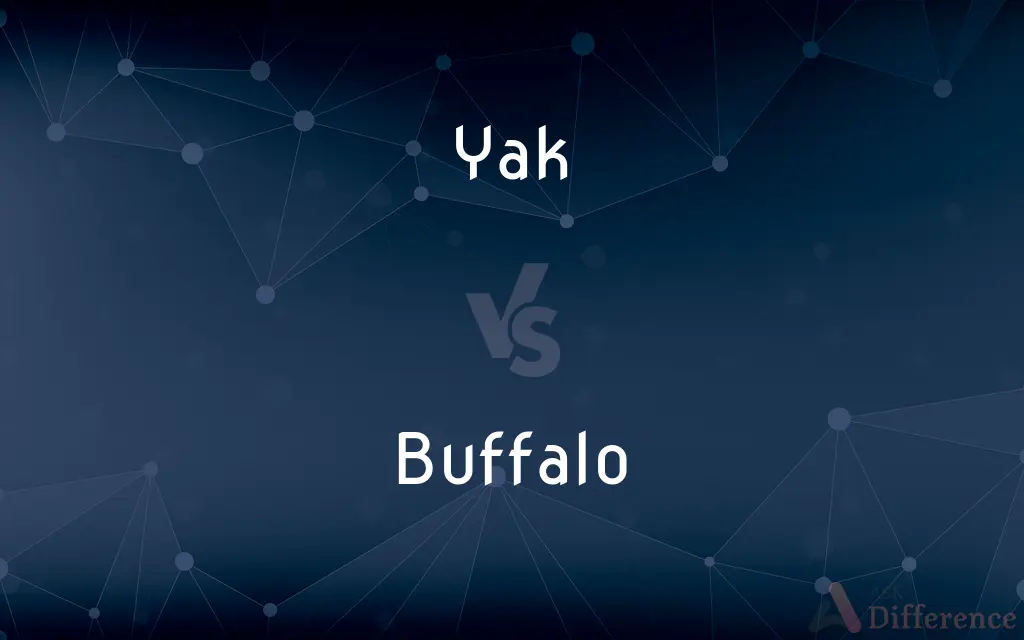Yak vs. Buffalo — What's the Difference?
By Tayyaba Rehman — Published on September 1, 2023
Yaks are long-haired bovines native to the Himalayan region, while buffaloes are large herbivores found in Africa and Asia.

Difference Between Yak and Buffalo
Table of Contents
ADVERTISEMENT
Key Differences
The yak is a unique, high-altitude bovid native to the Himalayan region, particularly Tibet and Nepal. In contrast, the term buffalo encompasses a variety of large bovine species found in various parts of the world, including the African water buffalo and the American bison.
Yaks have thick, long hair, which not only protects them from the cold but also becomes a valuable resource for local populations. The buffalo, on the other hand, has shorter hair suitable to its warmer climates, be it the plains of North America or the swamps of Africa.
The yak's habitat, the Himalayas, is characterized by steep terrains, cold weather, and high altitudes. Buffaloes are more versatile in their habitats, with species like the African buffalo thriving in savannahs and forests and the American bison roaming the vast North American plains.
Yaks have been deeply integrated into the cultures of the Himalayan peoples, providing milk, meat, and transport. While buffaloes are also significant to their native regions, their roles differ. For example, in Asia, the water buffalo has been historically important for farming, while the American bison held cultural and spiritual significance for Native American tribes.
While both yaks and buffaloes have been domesticated to some degree, yaks tend to be more agile and can navigate rugged terrains efficiently. In comparison, buffaloes, particularly the domesticated varieties, are more often associated with strength and endurance in flatter landscapes.
ADVERTISEMENT
Comparison Chart
Native Region
Himalayan regions of Tibet and Nepal
Various (e.g., North America, Africa, Asia)
Hair Length
Long and thick
Generally shorter
Typical Habitat
High-altitude, cold, mountainous
Plains, savannahs, forests, swamps
Cultural Significance
Transport, meat, milk
Farming (Asia), spiritual (Native Americans)
Domestication
More agile in rugged terrains
Known for strength in flatter landscapes
Compare with Definitions
Yak
A large, domesticated wild ox with shaggy hair, humped shoulders, and large horns.
The yak is an indispensable animal for the Tibetan nomads.
Buffalo
A large herbivorous mammal with a massive head, broad shoulders, and strong, curved horns.
The buffalo roamed the vast plains in huge herds.
Yak
The hair of the yak, often used in weaving.
Her shawl, made from yak wool, was incredibly warm.
Buffalo
A city in western New York state.
Buffalo is known for its vibrant arts scene and historic architecture.
Yak
A loud, harsh laugh.
His story made me yak in surprise and amusement.
Buffalo
To confuse or deceive (someone).
The math problem managed to buffalo even the top students.
Yak
A prolonged talk or chat.
She had a good yak with her neighbor over coffee.
Buffalo
Leather made from buffalo hide.
His boots were made of fine buffalo leather.
Yak
A wild, shaggy-haired ox (Bos grunniens) of the mountains of central Asia.
Buffalo
The flesh of the American bison, used as food.
Yak
Noisy talk
Buffalo
Ellipsis of buffalo robe
Yak
Trivial or unduly prolonged conversation.
Buffalo
The buffalo fish (Ictiobus spp.).
Yak
(slang) A talk, particular an informal talk; chattering; gossip.
Buffalo
Any of several large African and Asian ruminant mammals of the family Bovidae, such as the water buffalo and the African buffalo.
Yak
(slang) A laugh.
Buffalo
The American bison (Bison bison).
Yak
To talk at length about trivial or boring subjects.
He tends to yak on about his vintage stamp collection.
Buffalo
Any of several North American suckers of the genus Ictiobus, having a dark body and an arched back. Also called buffalo fish.
Yak
The domestic yak (Bos grunniens) is a long-haired domesticated cattle found throughout the Himalayan region of the Indian subcontinent, the Tibetan Plateau, Northern Myanmar, Yunnan, Sichuan and as far north as Mongolia and Siberia. It is descended from the wild yak (Bos mutus).
Buffalo
To intimidate or frighten, as by a display of authority
“The board couldn't buffalo the federal courts as it had the Comptroller” (American Banker).
Yak
A large domesticated wild ox with shaggy hair, humped shoulders, and large horns, used in Tibet as a pack animal and for its milk, meat, and hide.
Buffalo
To confuse or deceive
“Too often ... job seekers have buffaloed lenders as to their competency and training” (H. Jane Lehman).
Yak
Talk at length about trivial or boring subjects
She wondered what he was yakking about
Buffalo
Any of the Old World mammals of the family Bovidae, such as the Cape buffalo, Syncerus caffer, or the water buffalo Bubalus bubalis.
Yak
A domesticated yak, used as a work animal or raised for meat and milk.
Buffalo
A related North American animal, the American bison, Bison bison.
Yak
Prolonged, sometimes senseless talk; chatter.
Buffalo
A nickel.
Yak
To talk persistently and meaninglessly; chatter.
Buffalo
(transitive) To hunt buffalo.
Yak
An ox-like mammal native to the Himalayas, Mongolia, Burma, and Tibet with dark, long, and silky hair, a horse-like tail, and a full, bushy mane.
Buffalo
To outwit, confuse, deceive, or intimidate.
Yak
(slang) Vomit.
Buffalo
To pistol-whip.
Yak
(slang) A kayak.
Buffalo
A species of the genus Bos or Bubalus (Bubalus bubalus), originally from India, but now found in most of the warmer countries of the eastern continent. It is larger and less docile than the common ox, and is fond of marshy places and rivers.
Yak
To talk, particularly informally but persistently; to chatter or prattle.
Buffalo
A very large and savage species of the same genus (Syncerus Caffer syn. Bubalus Caffer) found in South Africa; - called also Cape buffalo.
Yak
To vomit, usually as a result of excessive alcohol consumption.
Buffalo
Any species of wild ox.
Yak
Large long-haired wild ox of Tibet often domesticated
Buffalo
The bison of North America.
Yak
A bovine mammal (Poëphagus grunnies) native of the high plains of Central Asia. Its neck, the outer side of its legs, and its flanks, are covered with long, flowing, fine hair. Its tail is long and bushy, often white, and is valued as an ornament and for other purposes in India and China. There are several domesticated varieties, some of which lack the mane and the long hair on the flanks. Called also chauri gua, grunting cow, grunting ox, sarlac, sarlik, and sarluc.
Buffalo
A buffalo robe. See Buffalo robe, below.
Buffalo
The buffalo fish. See Buffalofish, below.
Buffalo
Large shaggy-haired brown bison of North American plains
Buffalo
A city on Lake Erie in western New York (near Niagara Falls)
Buffalo
Meat from an American bison
Buffalo
Any of several Old World animals resembling oxen including, e.g., water buffalo; Cape buffalo
Buffalo
Intimidate or overawe
Buffalo
A mozzarella cheese made from the milk of the Italian water buffalo.
Buffalo mozzarella is a delightful addition to salads.
Common Curiosities
Where can buffaloes be typically found?
Buffaloes can be found in various parts of the world, including North America, Africa, and Asia.
Can the term 'buffalo' refer to the American bison?
Yes, in North America, the term 'buffalo' is colloquially used to refer to the American bison.
What is a yak typically known for?
A yak is known for its long, shaggy hair and its ability to thrive in high-altitude regions like the Himalayas.
Are both yaks and buffaloes domesticated?
Yes, both yaks and buffaloes have been domesticated, serving various purposes in their respective regions.
Are there any cities named after the buffalo?
Yes, Buffalo is a city in western New York state.
Is yak hair of any significant use?
Yes, yak hair is often used in weaving and is known for its warmth.
How do the habitats of yaks and buffaloes differ?
Yaks are adapted to cold, mountainous regions, while buffaloes thrive in plains, savannahs, forests, and swamps.
Is the term 'yak' ever used to refer to talking?
Yes, 'yak' can colloquially mean a prolonged talk or chat.
Can the word 'buffalo' be used as a verb?
Yes, 'buffalo' can mean to confuse or deceive someone.
How are buffaloes significant in Asian cultures?
In Asia, especially in countries like India and the Philippines, buffaloes have been historically important for farming.
Share Your Discovery

Previous Comparison
Trusing vs. Trussing
Next Comparison
Review vs. EvaluateAuthor Spotlight
Written by
Tayyaba RehmanTayyaba Rehman is a distinguished writer, currently serving as a primary contributor to askdifference.com. As a researcher in semantics and etymology, Tayyaba's passion for the complexity of languages and their distinctions has found a perfect home on the platform. Tayyaba delves into the intricacies of language, distinguishing between commonly confused words and phrases, thereby providing clarity for readers worldwide.















































